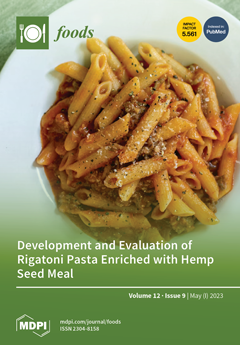To investigate the effect of
n-butanol on postharvest membrane lipid metabolism of Hami melon (Cucumis melo ‘Hami’), the fruits were soaked in a 1.0% solution of
n-butanol for 30 min with water as the control. Symptoms of chilling injury were observed
[...] Read more.
To investigate the effect of
n-butanol on postharvest membrane lipid metabolism of Hami melon (Cucumis melo ‘Hami’), the fruits were soaked in a 1.0% solution of
n-butanol for 30 min with water as the control. Symptoms of chilling injury were observed regularly, and the indices related to permeability and membrane lipid metabolism of pericarp cells were measured. The results showed that treatment with
n-butanol inhibited the increase in chilling injury index, membrane permeability, and malondialdehyde content of Hami melon fruits, promoted an increase in the contents of phosphatidyl alcohol and unsaturated fatty acids, such as linoleic acid, linolenic acid, oleic acid (except 14 d), and erucic acid (28–42 d), and decreased the content of saturated fatty acids, stearic acid (0–28 d), phosphatidic acid (except for 21 d), and the key enzymes of membrane lipid metabolism compared with the control. The activities of phospholipase D (PLD) and lipoxygenase (LOX) and the downregulation of the levels of expression
CmPLD-β and
CmLOX (42 d only) genes reduced the chilling injury index of Hami melon and alleviated the further expansion of chilling injury symptoms in the fruits. We also cloned the key gene of membrane lipid metabolism
CmPLD-β, which was obtained by pre-transcriptome screening of the pericarp. We found that
CmPLD-β of Hami melon had the closest affinity with cucumber (CsXP5), indicating that the
CmPLD-β gene of Hami melon was functionally similar to that of cucumber. In addition, a two-fold alignment analysis of
CmPLD-β and CmXP5 base sequences indicated that the base sequences of the two promoter regions differed from each other.
Full article






